Longitudinal position of the fins
The definition of the maneuverability of a board is given by the effort required to rotate the board and its surfer along a given axis.
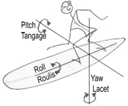
We showed in the chapter describing the outline that this effort varies with the distance separating the center of gravity of the surfer from the center of pivoting of the board.
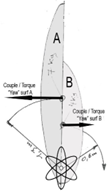 Maximum theoretical maneuverability is obtained when the surfer's center of gravity coincides exactly with the yaw axis (yaw). When the surfer engages in a radical turn, he brings his center of gravity back to the level of the overall center of lift of the fins, because any distance away from this point tends to increase the effort necessary to turn around this axis. When the rotation is finished, it moves forward in search of speed.
Maximum theoretical maneuverability is obtained when the surfer's center of gravity coincides exactly with the yaw axis (yaw). When the surfer engages in a radical turn, he brings his center of gravity back to the level of the overall center of lift of the fins, because any distance away from this point tends to increase the effort necessary to turn around this axis. When the rotation is finished, it moves forward in search of speed.
To illustrate this phenomenon, we will quote Christophe Mulquin. In his book analyzing the maneuvers of surfing (Mulquin), he describes the supports of the skates and the importance of sheathing the spine as well as : 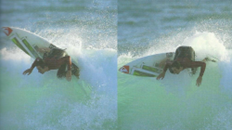 Roller on the aileron pivot center. Jeremy Flores (Mulquin, s.d.)
Roller on the aileron pivot center. Jeremy Flores (Mulquin, s.d.)
« …This rotating movement, fast, lively in balance, can only be of good quality if the supports are of good quality. There is a perfectly complementary sequence of support between the back and the front. During the lift phase, when you climb towards the lip, it is rather the rear support that is privileged. During the rotation on the lip, the support is essentially on the back foot which plays the role of pivot, of point of compass. During the descent phase, it is rather a front foot support that predominates. The problem of the supports on this maneuver is that there is an incessant succession of supports, there are perpetual corrections between the front, rear and lateral supports… The sheathing takes on its full meaning on the roller. A strong rota-tion of the upper part of the body is transmitted through the abdominal belt. The force of this torque is transmitted to the thighs… ».
The displacement on the back therefore aligns the center of gravity of the surfer with the effective pivot center of the board, resulting in large part from the position of the fins.
directional board under turns: the fin aligns the board in the flow and the fin remains well submerged.
Moving the fins forward decreases the fore-aft travel distance needed to merge these centers, making the board easier to maneuver and relaunch.
MBut advancing the fin too far degrades the stability of the board in the fast phases.
The front support on the submerged rail generates acceleration, but it must be compensated by a rearward position of the fins: A rearward fin drags the rear of the board in the direction of the relative flow. This results in automatic alignment of the board, positioning the front of the board facing the flow, and the stringer parallel to the direction of the relative flow. This self-stable character is directionality. (definition: directional character, of what orients) Directionality stabilizes the board and compensates for the drag of the front of the board, which tends to raise the nose towards the crest.
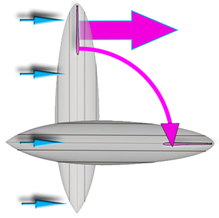 rear fin generating directionality.
rear fin generating directionality.
If the fin does not realign the back of the board in the flow, the trajectory of the surfer will rise too much and the stall of the rail will slow the surfer by putting him in the way. This happens when the fin vents, stalls, or breaks: the board spins, it survives. With a well set back and immersed fin, the surfer can go for a walk on the nose without changing the direction of the board. This behavior brings safety in big waves, it is the board that commands hang on and pray that the straight line is the right path! If the central fin is placed too far forward, it will also tend to come out of the water too often in fast vertical sections and excessive maneuverability can lead to instability, forcing the surfer to always maintain control without being able to rest. on the directionality of the board…
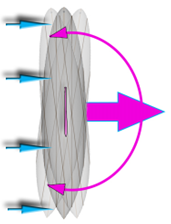 fin forward generating instability..
fin forward generating instability..
These effects result in a compromise between maneuverability and stability:
• Fin forward = maneuverability
• fins at rear= stability and directionality
Angle de Toe :
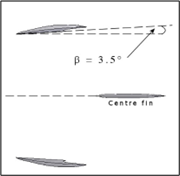
Classically the toe angle generates maneuverability and delays the stall in radical maneuvers by reducing the apparent angle of attack in curved trajectories. A profile with an extrados cambered in the direction of the desired lift unquestionably increases downforce, but also implies an antagonistic symmetry of the side fins. These static angle and camber antagonisms unfortunately induce drag and the obligation to take the antagonist fin out of the water to obtain clean maneuvers.
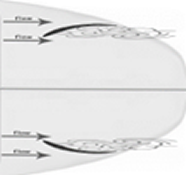
The recently introduced dynamic angle of attack and camber adaptation technology (ADAC Fynsurf system) eliminates harmful antagonism, and increases the positive effects of camber and angle of attack by adapting the camber and angle of all the fins following the dynamic trajectory of the surfer: Drag resulting from antagonist toe angles with traditional Static fins, and ADAC system with dynamically adapting toe angle:
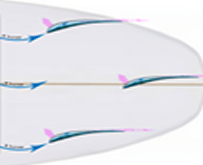
Cant angle:
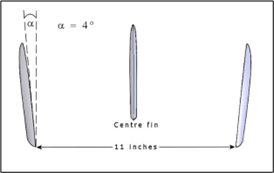
A fin is formed by stacks of profiles following one another along a generatrix. The lift of an aileron is perpendicular to the direction of the fluid, and perpendicular to the generatrix of the aileron. The cant angle therefore generates a component of lift directed towards the board, in proportions relative to the sine of this angle which is approximately 4° in conventional configurations. Note here that the sine of 4° = 0.069, so for a lift force of 10 Newtons the component resulting from the cant angle is 1*0.069= 69 grams. A cant angle of 4° therefore produces effects that are difficult to detect. In this case, this angle is more about aesthetics than performance.
.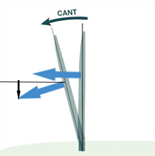
When cant angle is very important (90°), and the size of the fin approaches a wing, the effects on the balance of the board become very important. The hydrofoil is an example of this case where the lift of the fins becomes the most important part of the overall lift of the board.
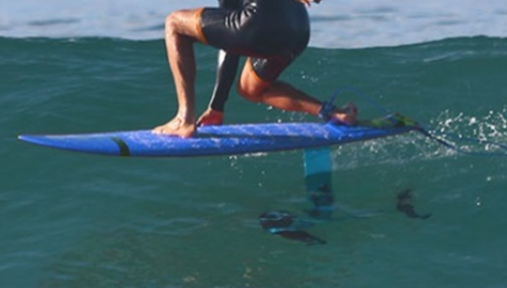
In this case the cant angle becomes the "dihedron" of the wing..

LAYOUT CONFIGURATIONS
SINGLE fin:
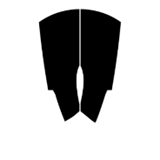
To steer their longboards without fins, surfers of the time (1930-1940) briefly dipped their feet in the water to turn the board. But the need to lean on to control the trajectory without skidding is very real. The invention of the surfboard fin can be attributed to Tom Blake in 1934.
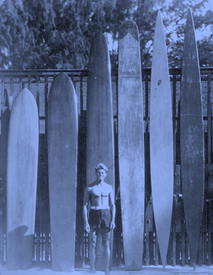 Tom Blake
Tom Blake
The installation of this fin revolutionizes surfing by allowing figures that were impossible before, it stabilizes the trajectory and takes better support on the rail while creating a rear pivot to turn and change direction. But despite its indisputable effectiveness, this innovation proposed by Blake in 1934, took time to be adopted because of its relative difficulty of implementation and the danger it constituted in the eyes of surfers of the time.
 fins 1935
fins 1935
What is amusing with hindsight is that this notion of danger has become natural, and that soft-edged fins are abandoned by the vast majority of surfers today, more afraid of denting their image of invincible warrior. rather than their disarmed bodies.
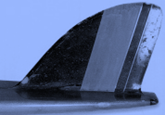
From 1935 to 1960 the height of the fin continues to increase, the fulcrum is more and more effective and allows increasingly tight turns, the radicality of the cut back and the bottom turn are linked to this evolution. The 1960 single reaches a limit that it cannot cross when it is implanted in the center of the board, the ventilation.
TWIN :
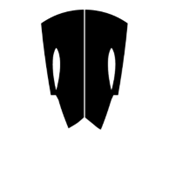
Simmons proposed the twin in 1949 to avoid the ventilation of the central fins which were too short:
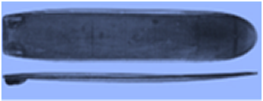
With Simmons' setup, even if one fin comes out of the water and vents due to a very vertical wave wall, or a turn causing a lot of roll, the underwater fin takes over, it you need a fin for the 2 sides of the turn encountered in the trajectories of the surf. The Simmons twin has almost parallel layouts. later, a slight toe angle will take into account the fact that the water flow comes from the side when riding a wave in its vertical zone.
Boards from the 70s get shorter and shorter, over time their maneuverability is increased as a result, and the turns therefore become more and more radical. The bends generate a variation in flow direction on the drifts
No turn: direction towards the beach, the water arrives parallel to the axis of the board.
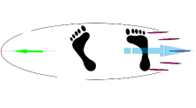
The rotational movement of the surfer causes a variation in the direction of the water on the fins during the turn.
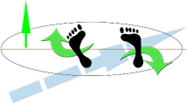
The more radical the rotational movement, and the more vertical the wave, the greater the angle of the water arriving on the daggerboards When the angle of attack of the fluid is too great, on the wing, as on the fin of surfing, the efficiency drops suddenly, it is the stall.
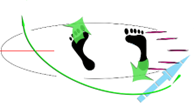
It is in the most pronounced cornering phase that this stall occurs. The solution to avoid, or postpone the stall, is to decrease the angle between the water and the fin. This is done by setting up the fin with a compensated angle for radical turns, this is the Toe angle (pinching of the fins which "squint" towards the front of the board).
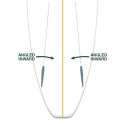
The Fish of the 70s, designed to play in small waves with radical turns, increases the toe angles, and advances the position of the fins to bring them closer to the surfer's center of gravity and generate maneuverability. But this is done at the expense of stability and becomes difficult to manage in larger waves where the directionality is a guarantee of tranquility.
thruster :
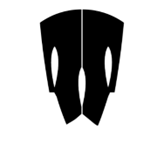
The solution to reconcile the pleasure of the handling of the twin and the soothing directionality of the single, is provided by the truster configuration. This configuration has been widely imposed over the years. But the drawback of a configuration with fins having opposing toe angles is higher braking than with parallel toe angles.
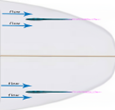
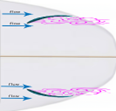
On the Fish, playful in small hollow waves, the good surfer takes the opposing fin out of the water as often as possible, and accepts braking in 90 percent of the time of his trajectories or he has the 2 fins in the water, but as we said, the Fish surfer is playful and does not seek speedy performance, he is a "skateboarder" spirit.
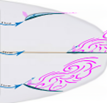 For the thruster, it's three different toe angles and the desire to surf sometimes powerful and fast waves, the performance degraded by the braking of fins with badly tuned angles can be a limit when the waves are very fast, big and throws his lip and the late surfer on a bed of corals.
For the thruster, it's three different toe angles and the desire to surf sometimes powerful and fast waves, the performance degraded by the braking of fins with badly tuned angles can be a limit when the waves are very fast, big and throws his lip and the late surfer on a bed of corals.
quad :
For demanding and high level surfers, surfing very hollow and fast waves, it may be of interest to place an advanced fin close to the rail to avoid ventilation and to have maneuverability, and another fin close to the rail also to not venting, and with a toe angle relatively close to its front buddy to avoid creating too much braking. The rear side fin provides stabilizing directionality in powerful waves where the error of trajectory is expensive! This configuration is advantageous for very fast and very vertical waves, implying that only two fins are submerged, and that the opposing fins are out of the water. This type of 4-fin configuration finds its application in exceptional waves surfed by exceptional surfers! But it can also be useful to create a twin configuration, which can be modified according to surfing conditions, and switch from the twin Fish configuration with strong toe angles and fins on the front, to create great maneuverability and a very playful character. , and then switch to a Simmons type twin with the fins set back and almost parallel and thus offer a fast board in hollow waves. The slots will therefore be useful but not all used at the same time. It is certainly the most useful job of this configuration for 90% of surfers.
Five fins:
 Comme le quad mais avec une possibilité de configuration en thruster ou single, cette Like the quad but with the possibility of a thruster or single configuration, this configuration is perfect for surfers wishing to test the best configurations according to their mood and type of wave of the day. The surfer asking his shaper for this type of configuration has fallen on the strength experimentation side, it is likely that he will never be able to come back from it because this quest is limitless !
Comme le quad mais avec une possibilité de configuration en thruster ou single, cette Like the quad but with the possibility of a thruster or single configuration, this configuration is perfect for surfers wishing to test the best configurations according to their mood and type of wave of the day. The surfer asking his shaper for this type of configuration has fallen on the strength experimentation side, it is likely that he will never be able to come back from it because this quest is limitless !
Duo :
 We have seen that the single found its limit when the radicality of the turns or the verticality of the wave combined with the speed of the section, requires the use of fins closer to the rail to limit ventilation and loss of grip. The duo configuration allows you to get closer to the rail so as not to ventilate when the center of the board comes out of the water, while maintaining parallel fins, so as not to lose speed due to the opposing toe angles braking. By keeping the center of lift close to the center of the board, the tilt effect is limited, and the immersion of the rail is easier, it is an interesting configuration for relatively slow waves requiring a large surface area. fins, and a surfer wishing to push the rail hard into carves or he risks pulling the central fin out of the water.
We have seen that the single found its limit when the radicality of the turns or the verticality of the wave combined with the speed of the section, requires the use of fins closer to the rail to limit ventilation and loss of grip. The duo configuration allows you to get closer to the rail so as not to ventilate when the center of the board comes out of the water, while maintaining parallel fins, so as not to lose speed due to the opposing toe angles braking. By keeping the center of lift close to the center of the board, the tilt effect is limited, and the immersion of the rail is easier, it is an interesting configuration for relatively slow waves requiring a large surface area. fins, and a surfer wishing to push the rail hard into carves or he risks pulling the central fin out of the water.
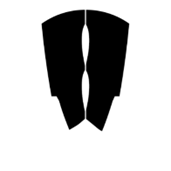
Fyn line :
When the single does not offer enough lift in the waves that open without generating high speeds, a larger fin surface may be necessary. But the desire to maintain optimum rail support by limiting the cant as much as possible imposes a central position of the center of lift of the fin. This setup is only applicable with dynamic fins, generating maneuverability through their adaptable dynamic toe angles.